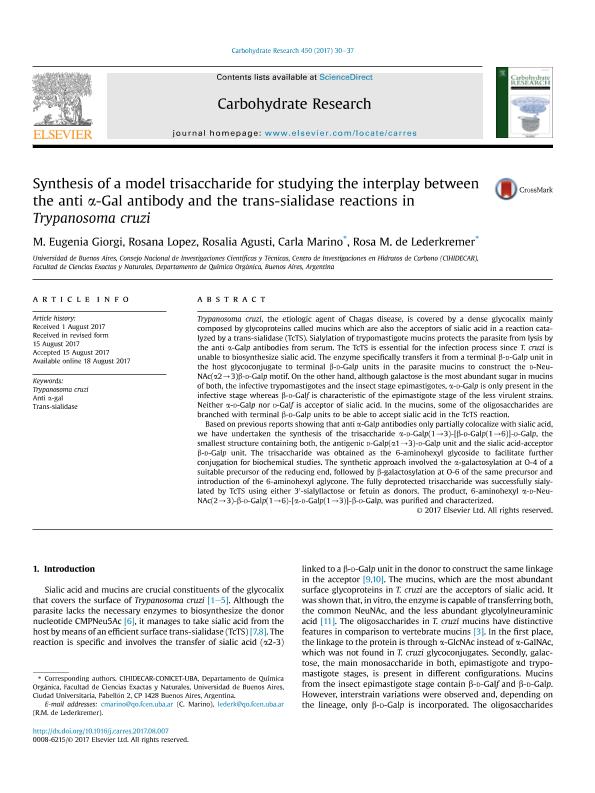Mostrar el registro sencillo del ítem
dc.contributor.author
Giorgi, María Eugenia

dc.contributor.author
Lopez, Laura Rosana

dc.contributor.author
Agusti, Rosalia

dc.contributor.author
Marino, María Carla

dc.contributor.author
Muchnik, Rosa

dc.date.available
2018-09-07T18:44:21Z
dc.date.issued
2017-10
dc.identifier.citation
Giorgi, María Eugenia; Lopez, Laura Rosana; Agusti, Rosalia; Marino, María Carla; Muchnik, Rosa; Synthesis of a model trisaccharide for studying the interplay between the anti α-Gal antibody and the trans-sialidase reactions in Trypanosoma cruzi; Elsevier; Carbohydrate Research; 450; 10-2017; 30-37
dc.identifier.issn
0008-6215
dc.identifier.uri
http://hdl.handle.net/11336/58781
dc.description.abstract
Trypanosoma cruzi, the etiologic agent of Chagas disease, is covered by a dense glycocalix mainly composed by glycoproteins called mucins which are also the acceptors of sialic acid in a reaction catalyzed by a trans-sialidase (TcTS). Sialylation of trypomastigote mucins protects the parasite from lysis by the anti α-Galp antibodies from serum. The TcTS is essential for the infection process since T. cruzi is unable to biosynthesize sialic acid. The enzyme specifically transfers it from a terminal β-D-Galp unit in the host glycoconjugate to terminal β-D-Galp units in the parasite mucins to construct the D-NeuNAc(α2→3)β-D-Galp motif. On the other hand, although galactose is the most abundant sugar in mucins of both, the infective trypomastigotes and the insect stage epimastigotes, α-D-Galp is only present in the infective stage whereas β-D-Galf is characteristic of the epimastigote stage of the less virulent strains. Neither α-D-Galp nor D-Galf is acceptor of sialic acid. In the mucins, some of the oligosaccharides are branched with terminal β-D-Galp units to be able to accept sialic acid in the TcTS reaction. Based on previous reports showing that anti α-Galp antibodies only partially colocalize with sialic acid, we have undertaken the synthesis of the trisaccharide α-D-Galp(1→3)-[β-D-Galp(1→6)]-D-Galp, the smallest structure containing both, the antigenic D-Galp(α1→3)-D-Galp unit and the sialic acid-acceptor β-D-Galp unit. The trisaccharide was obtained as the 6-aminohexyl glycoside to facilitate further conjugation for biochemical studies. The synthetic approach involved the α-galactosylation at O-4 of a suitable precursor of the reducing end, followed by β-galactosylation at O-6 of the same precursor and introduction of the 6-aminohexyl aglycone. The fully deprotected trisaccharide was successfully sialylated by TcTS using either 3′-sialyllactose or fetuin as donors. The product, 6-aminohexyl α-D-NeuNAc(2→3)-β-D-Galp(1→6)-[α-D-Galp(1→3)]-β-D-Galp, was purified and characterized.
dc.format
application/pdf
dc.language.iso
eng
dc.publisher
Elsevier

dc.rights
info:eu-repo/semantics/openAccess
dc.rights.uri
https://creativecommons.org/licenses/by-nc-sa/2.5/ar/
dc.subject
Anti Α-Gal
dc.subject
Trans-Sialidase
dc.subject
Trypanosoma Cruzi
dc.subject.classification
Otras Ciencias Químicas

dc.subject.classification
Ciencias Químicas

dc.subject.classification
CIENCIAS NATURALES Y EXACTAS

dc.title
Synthesis of a model trisaccharide for studying the interplay between the anti α-Gal antibody and the trans-sialidase reactions in Trypanosoma cruzi
dc.type
info:eu-repo/semantics/article
dc.type
info:ar-repo/semantics/artículo
dc.type
info:eu-repo/semantics/publishedVersion
dc.date.updated
2018-09-07T13:51:00Z
dc.journal.volume
450
dc.journal.pagination
30-37
dc.journal.pais
Países Bajos

dc.journal.ciudad
Amsterdam
dc.description.fil
Fil: Giorgi, María Eugenia. Consejo Nacional de Investigaciones Científicas y Técnicas. Oficina de Coordinación Administrativa Ciudad Universitaria. Centro de Investigaciones en Hidratos de Carbono. Universidad de Buenos Aires. Facultad de Ciencias Exactas y Naturales. Centro de Investigaciones en Hidratos de Carbono; Argentina
dc.description.fil
Fil: Lopez, Laura Rosana. Consejo Nacional de Investigaciones Científicas y Técnicas. Oficina de Coordinación Administrativa Ciudad Universitaria. Centro de Investigaciones en Hidratos de Carbono. Universidad de Buenos Aires. Facultad de Ciencias Exactas y Naturales. Centro de Investigaciones en Hidratos de Carbono; Argentina
dc.description.fil
Fil: Agusti, Rosalia. Consejo Nacional de Investigaciones Científicas y Técnicas. Oficina de Coordinación Administrativa Ciudad Universitaria. Centro de Investigaciones en Hidratos de Carbono. Universidad de Buenos Aires. Facultad de Ciencias Exactas y Naturales. Centro de Investigaciones en Hidratos de Carbono; Argentina
dc.description.fil
Fil: Marino, María Carla. Consejo Nacional de Investigaciones Científicas y Técnicas. Oficina de Coordinación Administrativa Ciudad Universitaria. Centro de Investigaciones en Hidratos de Carbono. Universidad de Buenos Aires. Facultad de Ciencias Exactas y Naturales. Centro de Investigaciones en Hidratos de Carbono; Argentina
dc.description.fil
Fil: Muchnik, Rosa. Consejo Nacional de Investigaciones Científicas y Técnicas. Oficina de Coordinación Administrativa Ciudad Universitaria. Centro de Investigaciones en Hidratos de Carbono. Universidad de Buenos Aires. Facultad de Ciencias Exactas y Naturales. Centro de Investigaciones en Hidratos de Carbono; Argentina
dc.journal.title
Carbohydrate Research

dc.relation.alternativeid
info:eu-repo/semantics/altIdentifier/doi/https://dx.doi.org/10.1016/j.carres.2017.08.007
dc.relation.alternativeid
info:eu-repo/semantics/altIdentifier/url/https://www.sciencedirect.com/science/article/pii/S0008621517305256
Archivos asociados
